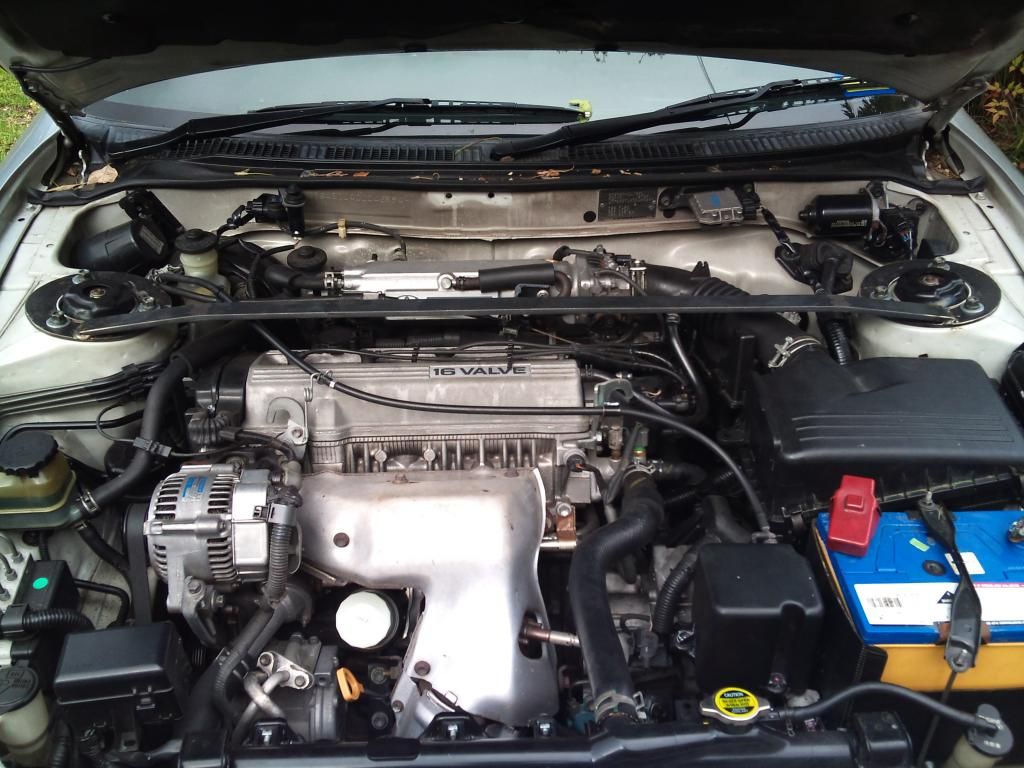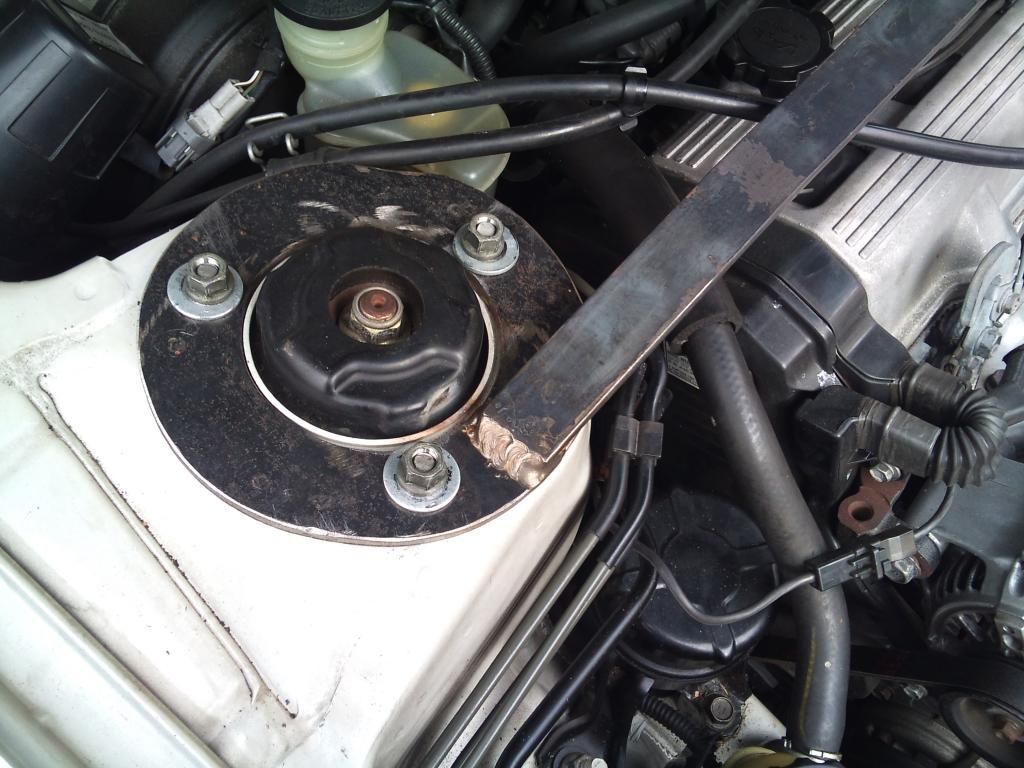 Nov 22, 2012 - 12:36 AM Nov 22, 2012 - 12:36 AM
|
|
|
Enthusiast  Joined Sep 30, '11 From Sydney Currently Offline Reputation: 0 (0%) |
So made a strut bar today all fits perfectly, is beefy as all hell but then I decide to try and shut the bonnet.....
When I was measuring it, I didnt notice the support bars running along the underside of the bonnet and of course with my luck they hit the strut bar preventing me from closing the bonnet So now I need some ideas from you guys on how to modify the strut bar without starting again. My favourite idea is cutting the bar in the middle and bashing the bends at either end down a little but and then re-welding it in the middle. My concern is strength when it is re-welded. OR I can grind off the welds at each end and make the bends a slightly lesser angle. Prefer not to do this one but if its the best option I guess I have no choice. If theres any other ideas you guys/gals can think of let me know or please critique mine just above. It is going to become a 3-pt bar just trying to sort two out first. Here are the pics:   
|
 |
Replies
 Nov 23, 2012 - 11:24 PM Nov 23, 2012 - 11:24 PM
|
|
|
Enthusiast  Joined Sep 30, '11 From Sydney Currently Offline Reputation: 0 (0%) |
Have you used Abaqus before? Is that the simulation environment inside Solidworks? if so only once, I mainly use ANSYS interesting, i would run it again with a straight bar, I think the bend would cause more deflection than a shorter straight bar. Just a guess, I have no software to test this, but I have been making parts on cnc mills for 20 years, so understanding rigidity is something I have tried a time or 2. afaik the bend seen in some bars is a clearance thing for top mount IC, I doubt it is adding any rigidity. Bicycle frames and forks are a good example of rigidity in action, the materials used have a lot to do with it also. Chrome moly should be a great strut bar material imo. A straight bar will withstand ALOT more force than a bent bar of any sort. This is due to a buckling situation that we encounter as both sides are in compression and fixed. Doing the calculation for the flat bar I used I found that it will take a compression force of 8909.29 N at each end to cause the bar to begin to bend. The other reason that a bend is necessary is due to things getting in the way like, air intake piping, bonnet supports, throttle cable. So really it becomes impractical unfortunately. flat should be fine...  i would add the little triangles at the end of mine If that's the J-speed one, that's what modeled mine off, I just couldn't be bothered to make the triangles haha If my thesis supervisor is feeling nice after Christmas i might even try to persuade him to let me hook some strain gauges up to it and then we can get a pretty good idea of what kind of forces are being put on the bar. |
 Nov 24, 2012 - 4:18 PM Nov 24, 2012 - 4:18 PM
|
|
|
Enthusiast     Joined Mar 3, '05 From Richmond, B.C. Currently Offline Reputation: 0 (0%) |
If my thesis supervisor is feeling nice after Christmas i might even try to persuade him to let me hook some strain gauges up to it and then we can get a pretty good idea of what kind of forces are being put on the bar. Make sure to throw the stock one on there for a test, see just how flexible its tubular design is in comparison to something made out of flat metal stock. |
Posts in this topic
 UVZ164 Strut bar fabrication gone wrong Nov 22, 2012 - 12:36 AM
UVZ164 Strut bar fabrication gone wrong Nov 22, 2012 - 12:36 AM
 njccmd2002 get a GT4 hood... Tha strut bar looks great!... Nov 22, 2012 - 2:12 AM
njccmd2002 get a GT4 hood... Tha strut bar looks great!... Nov 22, 2012 - 2:12 AM
 Tigawoods you lost me after i read "bashing" Nov 22, 2012 - 2:16 AM
Tigawoods you lost me after i read "bashing" Nov 22, 2012 - 2:16 AM
 nsxtypeR Get rid of the bends and you'll be fine. I wou... Nov 22, 2012 - 8:19 AM
nsxtypeR Get rid of the bends and you'll be fine. I wou... Nov 22, 2012 - 8:19 AM
 richee3 That strut bar looks good! Are you able to sta... Nov 22, 2012 - 10:35 AM
richee3 That strut bar looks good! Are you able to sta... Nov 22, 2012 - 10:35 AM
 Bitter flat bar will bow upward under stress. Nov 22, 2012 - 11:04 AM
Bitter flat bar will bow upward under stress. Nov 22, 2012 - 11:04 AM
 Xander_X What about if you turn it around so the crossbar i... Nov 22, 2012 - 11:04 AM
Xander_X What about if you turn it around so the crossbar i... Nov 22, 2012 - 11:04 AM
 199celica Add some hood spacers dude that's what I did i... Nov 22, 2012 - 5:06 PM
199celica Add some hood spacers dude that's what I did i... Nov 22, 2012 - 5:06 PM
 UVZ164 QUOTE (njccmd2002 @ Nov 22, 2012 - 3... Nov 22, 2012 - 6:53 PM
UVZ164 QUOTE (njccmd2002 @ Nov 22, 2012 - 3... Nov 22, 2012 - 6:53 PM

 97lestyousay QUOTE (UVZ164 @ Nov 22, 2012 - 3:53 ... Nov 24, 2012 - 8:13 AM
97lestyousay QUOTE (UVZ164 @ Nov 22, 2012 - 3:53 ... Nov 24, 2012 - 8:13 AM
 Tigawoods Add spacers to the bolts that attatch your hood. Y... Nov 22, 2012 - 10:24 PM
Tigawoods Add spacers to the bolts that attatch your hood. Y... Nov 22, 2012 - 10:24 PM
 UVZ164 Ye, had a look and didn't wanna do the hood sp... Nov 22, 2012 - 10:39 PM
UVZ164 Ye, had a look and didn't wanna do the hood sp... Nov 22, 2012 - 10:39 PM
 UVZ164 And then 2-points became 3!!
Have... Nov 23, 2012 - 1:45 AM
UVZ164 And then 2-points became 3!!
Have... Nov 23, 2012 - 1:45 AM
 Special_Edy Dont paint it, sand it and clear coat it, it will ... Nov 23, 2012 - 3:33 AM
Special_Edy Dont paint it, sand it and clear coat it, it will ... Nov 23, 2012 - 3:33 AM
 97lestyousay The fab work looks pretty good, but as was stated ... Nov 23, 2012 - 4:47 AM
97lestyousay The fab work looks pretty good, but as was stated ... Nov 23, 2012 - 4:47 AM
 UVZ164 QUOTE (Special_Edy @ Nov 23, 2012 - 3... Nov 23, 2012 - 9:32 AM
UVZ164 QUOTE (Special_Edy @ Nov 23, 2012 - 3... Nov 23, 2012 - 9:32 AM
 Bitter Replace the bar with tube and you have a nice desi... Nov 23, 2012 - 4:08 PM
Bitter Replace the bar with tube and you have a nice desi... Nov 23, 2012 - 4:08 PM
 UVZ164 Ok guys, since i'm studying mechanical enginee... Nov 23, 2012 - 8:12 PM
UVZ164 Ok guys, since i'm studying mechanical enginee... Nov 23, 2012 - 8:12 PM
 enderswift Have you used Abaqus before? Nov 23, 2012 - 10:06 PM
enderswift Have you used Abaqus before? Nov 23, 2012 - 10:06 PM
 97lestyousay interesting, i would run it again with a straight... Nov 23, 2012 - 10:34 PM
97lestyousay interesting, i would run it again with a straight... Nov 23, 2012 - 10:34 PM
 njccmd2002 flat should be fine...
i would add the little t... Nov 23, 2012 - 10:57 PM
njccmd2002 flat should be fine...
i would add the little t... Nov 23, 2012 - 10:57 PM
 njccmd2002 J speed it is!! Nov 23, 2012 - 11:36 PM
njccmd2002 J speed it is!! Nov 23, 2012 - 11:36 PM  |
1 User(s) are reading this topic (1 Guests and 0 Anonymous Users)
0 Members:
| Lo-Fi Version | Time is now: November 29th, 2024 - 5:34 PM |




